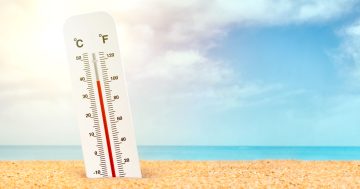
If you love the great outdoors on a sweltering day, spare a second to think about those who aren’t so lucky this Extreme Heat Awareness Day. Photo: James Coleman.
Australia’s deadliest natural disaster isn’t flood or fire – it’s heat, according to the Australian Institute of Health and Welfare.
As hot days become more frequent – 2024 was the hottest year for the planet on record – more people will suffer heat-related injury and death.
Healthy Cities Illawarra hopes to spread awareness of the impact of extreme heat, and what can be done to mitigate it as part of the first Extreme Heat Awareness Day on 5 February.
An initiative of Sweltering Cities, the day is an opportunity to urge local and state governments to act quickly to better prepare for the growing risks posed by extreme heat.
Healthy Cities Illawarra Health Promotion Officer Alexander Brown said there was plenty that could be done to reduce temperatures in urban areas.
“Many new housing developments include dark coloured surfaces, large amounts of concrete, and few trees,” he said.
“These factors contribute to making the environment hotter.
“Greening our cities by increasing the number of parks and tree canopy cover, reducing hard surfaces and installing light-coloured roofs in new builds will make our suburbs more resilient to heatwaves.
“Shaded footpaths and cool bus shelters can reduce the impact of heat on lower-income people, and help to reduce transport-related emissions, and slow global warming.”
It’s not just about government action, though.
Alexander said there were plenty of things individuals could do to help keep themselves, their families and their community safe during hot weather.
The first is to be mindful about who is most at risk.
The very young, elderly and people living with a disability or chronic disease are particularly vulnerable to heat-related injury and death.
For people with asthma, for example, variations in temperature can lead to flare-ups.
“Think about relatives and people in your community who might be vulnerable and check in on them on hot days,” Alexander said.
“Keep an eye out for heatstroke and heat exhaustion, but be aware heat can exacerbate the symptoms of other conditions too.
“If you’re at risk, talk to your doctor about the best way to manage in the heat.
“Have a plan to stay out of the sun and keep cool. Even a couple of degrees can make a difference.
“If you’re a homeowner, planting the right trees in the right places can help reduce heat, especially in suburbs with low canopy cover, like Port Kembla.”
There are some handy online resources for navigating hot days.
NSW Health’s ‘Beat the heat’ website provides detailed information on how to stay cool, healthy, and safe in hot weather.
The University of Sydney’s HeatWatch website provides a personalised heat health risk forecast and cooling recommendations based on real-time weather data for your area.
Sweltering Cities has resources on how you can join the push to get action on heatwaves.













